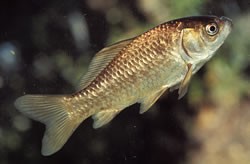About invasive fish

What is an invasive or high-risk fish?
Invasive or high-risk fish are:
- prohibited noxious fish under Queensland legislation
- restricted noxious fish under Queensland legislation
- escaped or released ornamental fish
- escaped or released game fish
- released native fish that are not native to that area.
Impacts to native fish
Non-native fish should never be released into Queensland's natural waterways and dams, as they may affect native fish by:
- reducing local native fish numbers
- aggressively competing for food and space
- becoming their prey
- altering and disturbing their habitat
- introducing exotic diseases and parasites.
Invasive fish are fish species that are not native to an area and have potential negative social, economic or environmental impacts. Ornamental fish become high-risk fish when released into the wild. Most high-risk ornamental fish established in Queensland waters have been released by irresponsible members of the public.
If you release ornamental fish into waterways and dams, they can become high-risk fish. Guppies, native to South America and the Caribbean, probably escaped from fish tanks into the wild to become invasive fish. In the wild, guppies breed very rapidly and efficiently and compete with native fish for food and space.
Invasive fish have successfully invaded Australian waters with one or more of the following attributes—they:
- tolerate diverse environments
- have flexible food needs
- reproduce rapidly
- mature early
- behave aggressively
- have few predators and competitors.
Invasive fish often inhabit and flourish in disturbed waterways (e.g. stagnant creeks, drains) as these often have abundant food resources and lack native fishes because of harsh and changed environmental conditions.
Further information
Contact the Customer Service Centre


